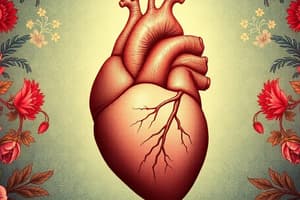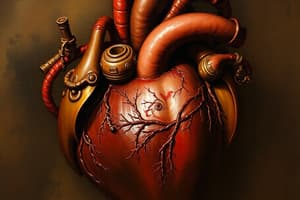Podcast
Questions and Answers
What is the typical range for normal cardiac output in liters of blood per minute?
What is the typical range for normal cardiac output in liters of blood per minute?
- 4-8 Liters (correct)
- 2-6 Liters
- 8-12 Liters
- 6-10 Liters
The resistance or pressure the heart must overcome to eject blood into the peripheral vasculature defines which component of cardiac output?
The resistance or pressure the heart must overcome to eject blood into the peripheral vasculature defines which component of cardiac output?
- Preload
- Heart Rate
- Contractility
- Afterload (correct)
Which of the following best describes the effect of tachycardia on cardiac output if filling time is compromised?
Which of the following best describes the effect of tachycardia on cardiac output if filling time is compromised?
- Increases cardiac output by increasing heart rate.
- Maintains cardiac output by enhancing contractility.
- Has no significant effect on cardiac output.
- Decreases cardiac output due to reduced ventricular filling. (correct)
Fluid volume overload primarily affects cardiac output by increasing which factor?
Fluid volume overload primarily affects cardiac output by increasing which factor?
Vasodilation affects afterload in what manner?
Vasodilation affects afterload in what manner?
Bradycardia can decrease cardiac output because it primarily results in:
Bradycardia can decrease cardiac output because it primarily results in:
The most common type of cardiomyopathy is characterized by what?
The most common type of cardiomyopathy is characterized by what?
Which component of ventricular function is typically impaired in patients with cardiomyopathy?
Which component of ventricular function is typically impaired in patients with cardiomyopathy?
Heart failure is defined as the inability of the heart muscle to do what?
Heart failure is defined as the inability of the heart muscle to do what?
What characterizes systolic heart failure?
What characterizes systolic heart failure?
What is the primary issue in diastolic heart failure?
What is the primary issue in diastolic heart failure?
Reduced cardiac output from the right side of the heart typically causes:
Reduced cardiac output from the right side of the heart typically causes:
Right sided heart failure caused by pulmonary hypertension is called what?
Right sided heart failure caused by pulmonary hypertension is called what?
In the classification of heart failure, a patient with Class II symptoms experiences symptoms during:
In the classification of heart failure, a patient with Class II symptoms experiences symptoms during:
What is one result of reduced cardiac output?
What is one result of reduced cardiac output?
Activation of compensatory mechanisms in heart failure can ultimately lead to:
Activation of compensatory mechanisms in heart failure can ultimately lead to:
Metoprolol is what type of medication?
Metoprolol is what type of medication?
Spironolactone is what type of medication?
Spironolactone is what type of medication?
Canagliflozin is what type of medication?
Canagliflozin is what type of medication?
For heart failure patients, what is the minimum number of medication types should they be prescribed upon discharge?
For heart failure patients, what is the minimum number of medication types should they be prescribed upon discharge?
Flashcards
Cardiac Output (CO)
Cardiac Output (CO)
The volume of blood the heart pumps per minute, normally 4-8 liters.
Stretch or Filling
Stretch or Filling
The degree of muscle fiber stretching in the ventricles before contraction.
Afterload
Afterload
The resistance the heart must overcome to eject blood into the peripheral vasculature.
Filling time
Filling time
Signup and view all the flashcards
How hard the muscle contracts
How hard the muscle contracts
Signup and view all the flashcards
Fluid Volume Overload
Fluid Volume Overload
Signup and view all the flashcards
Vasoconstriction
Vasoconstriction
Signup and view all the flashcards
Tachycardia
Tachycardia
Signup and view all the flashcards
Bradycardia
Bradycardia
Signup and view all the flashcards
Diuretics or Dehydration
Diuretics or Dehydration
Signup and view all the flashcards
Vasodilation
Vasodilation
Signup and view all the flashcards
Most important electrolyte
Most important electrolyte
Signup and view all the flashcards
Cardiomyopathy
Cardiomyopathy
Signup and view all the flashcards
Most common type of cardiomyopathy
Most common type of cardiomyopathy
Signup and view all the flashcards
Impaired Ventricular Filling
Impaired Ventricular Filling
Signup and view all the flashcards
Genetic
Genetic
Signup and view all the flashcards
Heart Failure
Heart Failure
Signup and view all the flashcards
Systolic heart failure
Systolic heart failure
Signup and view all the flashcards
Diastolic heart failure
Diastolic heart failure
Signup and view all the flashcards
Right Sided Heart Failure
Right Sided Heart Failure
Signup and view all the flashcards
Study Notes
- Normal cardiac output ranges from 4-8 Liters of blood/minute
- Cardiac output is the volume of blood the heart pumps to allow the body to work
4 Components of Cardiac Output
- Cardiac output is affected by stretch or filling, resistance or pressure, filling time, and how hard the muscle contracts
- Fluid volume overload causes an increase in preload
- Vasoconstriction causes an increase in afterload.
- Tachycardia causes a decrease in CO (cardiac output) because the ventricles don't have enough time to fill
- Dypsnea or Diminished preload causes a reduction of preload.
- Vasodilation causes a decrease in afterload.
- Bradycardia causes decreased cardiac output because not enough blood is circulating to meet the body's demands
- Electrolytes, specifically sodium, affect how hard the muscle contracts
Cardiomyopathy
-
Cardiomyopathy refers to diseases of the heart muscle that impair it's ability to pump blood
-
Most common type of cardiomyopathy is dilated cardiomyopathy
-
Impaired ventricular contraction or impaired ventricular relaxation may result from the disease
-
Cardiomyopathy may be genetic or acquired
-
Impaired ventricular contraction is associated with Heart Failure, reduced Ejection Fraction (HFrEF) and causes structural deformity. It impairs ventricular emptying.
-
Patient education should include the same recommendations for both types of cardiomyopathies
Heart Failure
- Heart failure is when the heart muscle can't pump enough blood to meet the body's demands, resulting in reduced cardiac output
Left Sided Heart failure
- Left-sided heart failure involves systolic and diastolic issues.
- Systolic heart failure results from a problem with contraction.
- Left ventricle is weak and enlarged in systolic heart failure
- Diastolic heart failure results from a problem with filling/relaxation
- Left ventricle is stiff and thick in diastolic heart failure
- Ejection Fraction (EF) should be between 55-65%.
- Reduced Ejection Fraction heart failure is also known as HFrEF
- Clinical manifestations of left-sided heart failure include:
- Dyspnea or shortness of breath
- Cough
- Crackles in the lungs
- Pulmonary edema
Right Sided Heart Failure
- Reduced cardiac output from the right side of the heart causes systemic issues
- Systemic issues from right sided heart failure
- Edema in the lower extremities.
- Jugular venous distension (JVD)
- Ascites
- When right-sided heart failure is caused by pulmonary hypertension it is called Cor Pulmonale
- Clinical manifestations of right-sided heart failure include:
- Peripheral edema
- Ascites
- Hepatomegaly
- JVD
Classification of Heart Failure
-
Class I heart failure includes patients with no symptoms
-
Class II heart failure includes symptoms with moderate exertion
-
Class III heart failure includes symptoms with minimal exertion
-
Class IV heart failure includes symptoms at rest
-
Reduced cardiac output can causes activation of the RAAS (renin-angiotensin-aldosterone) system and sympathetic nervous system
-
These compensatory mechanisms worsen heart failure instead of helping, as they increase afterload, cause vasoconstriction, and fluid retention
Pharmacological Treatments for HFrEF
- Shown to reduce mortality in Heart Failure with reduced ejection fraction (HFrEF)
- Angiotensin Receptor Neprilysin Inhibitors (ARNI) OR Angiotensin-converting-enzyme (ACE) Inhibitors OR Angiotensin Receptor Blockers (ARB)
- Beta Blockers such as Metoprolol
- Mineralocorticoid Receptor Antagonists (MRA) such as Spironolactone
- Sodium-glucose cotransporter-2 (SGLT2) inhibitors such as Canagliflozin
- All heart failure patients need to be on at least two of these medications before discharge:
- An ARNI OR ACE Inhibitor OR ARB
- AND a Beta Blocker
Studying That Suits You
Use AI to generate personalized quizzes and flashcards to suit your learning preferences.




